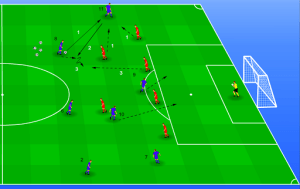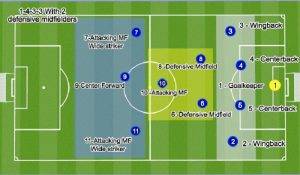In the intricate landscape of football, defensive positions serve as the guardians of the goal, the sentinels against opposing attacks, and the architects of a team’s defensive solidity. Each defensive position is a strategic piece in the chessboard of the pitch, contributing to the intricate dance of interceptions, tackles, and tactical acumen. In this comprehensive exploration, we unravel the nuances of defensive positions in football, delving into the roles, responsibilities, and strategic considerations that define each position.
Understanding Defensive Positions in Football
Foundation: Pillars of the Defensive Line
Goalkeeper (GK):
The custodian of the goal, the goalkeeper stands as the last line of defense. Tasked with stopping shots on goal, goalkeepers exhibit exceptional reflexes, positioning, and distribution skills. Their role extends beyond shot-stopping to organizing the defensive line during set-pieces and transitions.
Center-Back (CB):
Central defenders, often referred to as center-backs, form the backbone of the defense. Positioned centrally, they are the bulwark against opposing attacks. Center-backs excel in aerial duels, tackling, and reading the game to intercept passes. They are the defensive generals orchestrating the backline.
Full-Back (RB/LB):
Stationed on the right (RB) and left (LB) flanks, full-backs combine defensive solidity with offensive contributions. They defend against wingers and attackers while also supporting attacks by providing width. Modern full-backs are known for their overlapping runs, crosses, and versatility.
Defensive Midfielder (CDM):
The defensive midfielder acts as a shield in front of the defensive line. This player disrupts opposition attacks, wins back possession, and initiates counter-attacks. Known for ball-winning, tackling, and distributing the ball, defensive midfielders are the linchpins in transitioning from defense to offense.
Wing-Back (RWB/LWB):
In systems employing wing-backs, these players operate wider than traditional full-backs. Combining defensive and attacking responsibilities, wing-backs contribute defensively while making overlapping runs to provide width in the attack. Their role demands high levels of endurance and work rate.
Roles and Responsibilities by Defensive Position
Goalkeeper: The Last Line of Defense
Shot Stopping:
The goalkeeper’s primary duty is to make crucial saves, denying opponents’ attempts to score. Goalkeepers showcase agility, reflexes, and shot-stopping prowess to keep their team in the game.
Distribution:
Modern goalkeepers are proficient in distribution, using their feet to initiate attacks. Accurate passes and long kicks from the goalkeeper can transition the team from defense to offense swiftly.
Commanding the Box:
Goalkeepers command their penalty areas during set-pieces and crosses, organizing the defensive line and making decisions on when to come off their line to claim the ball.
Center-Back: Defensive Generals
Aerial Duels:
Center-backs dominate in aerial duels, using their height and timing to win headers and clear the ball from dangerous areas. Defending set-pieces and crosses is a crucial aspect of their role.
Tackling and Intercepting:
The ability to make well-timed tackles and intercept passes is vital for center-backs. They read the game, anticipate the movements of opposing attackers, and make interventions to regain possession.
Build-Up Play:
Modern center-backs are involved in the build-up play from the back. Comfortable on the ball, they initiate attacks by making accurate passes to teammates in more advanced positions.
Full-Back: Defensive Anchors with Attacking Flair
Defensive Solidity:
Full-backs excel in one-on-one defending against wingers and attackers. They use positioning, anticipation, and tackling skills to prevent opponents from creating goal-scoring opportunities.
Attacking Overlaps:
Contributing to the attack, full-backs make overlapping runs down the flanks. By providing width, they create space for wingers and deliver crosses into the box.
Balancing Defense and Attack:
The challenge for full-backs lies in balancing defensive responsibilities with attacking contributions. They must know when to stay back and defend and when to venture forward to support the attack.
Defensive Midfielder: The Shield in Midfield
Ball Recovery:
Defensive midfielders excel at winning back possession through ball recoveries and interceptions. Their ability to read the game and break up opposition attacks is crucial for defensive stability.
Distribution and Playmaking:
While primarily defensive, defensive midfielders contribute to ball circulation and playmaking. They distribute the ball to creative teammates and initiate attacks from a deeper position.
Screening the Defense:
Defensive midfielders act as a shield in front of the defensive line. They position themselves strategically to cut passing lanes, disrupt opposition build-up, and protect the back four.
Wing-Back: Dynamic Defenders and Attackers
Defensive Duties:
Wing-backs combine defensive duties with attacking responsibilities. They excel in one-on-one defending, track back to support the defensive line, and contribute to defensive solidity.
Attacking Overloads:
Contributing to attacking overloads, wing-backs provide an additional attacking option on the flanks. Overlapping runs and crosses create numerical advantages in wide areas.
Endurance and Work Rate:
The role demands high levels of endurance and work rate. Wing-backs cover significant distances during a match, participating in both defensive and attacking phases of play.
Strategic Considerations for Defensive Play
Defensive Shape and Compactness
Organized Defensive Shape:
Maintaining an organized defensive shape is a priority for teams. Defensive positions work cohesively to form a compact unit that denies space to the opposition.
Pressing and High Line:
Some teams employ a high defensive line and aggressive pressing to win the ball higher up the pitch. Defenders must be quick, alert, and capable of defending in advanced positions.
Zonal and Man-to-Man Marking:
Defenders use a combination of zonal and man-to-man marking to track opposition players. Zonal marking assigns defenders to specific areas, while man-to-man marking involves tracking and defending individual opponents.
Transition Defense: Quick Recovery and Regaining Possession
Counter-Pressing:
Teams focus on counter-pressing to quickly regain possession after losing the ball. Defenders press and harry opponents to disrupt their counter-attacks.
Transition to Attack:
Defensive positions contribute to the team’s transition to attack by making quick and accurate passes. Initiating attacks from the back requires defenders to be comfortable on the ball.
Regaining Shape:
After losing possession, defenders must quickly regain their defensive shape to nullify potential counter-attacks. Rapid reorganization is crucial to prevent the opposition from exploiting defensive gaps.
Evolution of Defensive Positions: Modern Trends
Versatile Defenders: Adapting to Changing Styles
Ball-Playing Defenders:
Modern defenders are expected to be comfortable on the ball and contribute to the build-up play. Ball-playing defenders initiate attacks from deep positions, adding an extra dimension to the team’s play.
Inverted Full-Backs:
Inverted full-backs cut inside onto their stronger foot, providing an additional layer of unpredictability to the attack. They contribute to interior passing and goal-scoring opportunities.
Hybrid Defenders:
The distinction between center-backs and full-backs has blurred with the emergence of hybrid defenders. These players possess the skills of both positions, allowing for tactical flexibility.
Famous Players and Defensive Icons
Legendary Defenders
Franz Beckenbauer (Center-Back):
Known as “Der Kaiser,” Franz Beckenbauer revolutionized the role of the sweeper as a ball-playing center-back. His elegance on the ball and defensive acumen made him a defensive icon.
Paolo Maldini (Center-Back/Left-Back):
Paolo Maldini, a legendary Italian defender, showcased versatility as both a center-back and left-back. His defensive prowess, leadership, and longevity defined an era.
Claude Makélélé (Defensive Midfielder):
Claude Makélélé, master of the defensive midfield role, was renowned for ball-winning, positional awareness, and acting as a deep-lying playmaker. The “Makélélé role” became synonymous with the position.
Dani Alves (Right-Back):
An attacking full-back, Dani Alves redefined the right-back position with overlapping runs, crosses, and goal-scoring ability. His contributions made him one of the greatest right-backs in history.
Virgil van Dijk (Center-Back):
A modern center-back, Virgil van Dijk exemplifies the ball-playing defender archetype. His composure on the ball, aerial dominance, and leadership contribute to defensive solidity.
Coaching Strategies: Balancing Defense and Attack
Defensive Drills and Tactical Sessions
Defensive Shape Drills:
Coaches emphasize drills that maintain a compact defensive shape. Players practice positioning, communication, and quick reactions to disrupt opposition attacks.
Pressing Exercises:
Pressing exercises help defenders coordinate pressing strategies. Winning the ball higher up the pitch limits the opposition’s time and space.
Transition Scenarios:
Coaches simulate transition scenarios in training to prepare defenders for quick recovery and regaining possession. Drills enhance players’ decision-making under pressure.
Related Post:
What Positions Are There in Soccer: A Comprehensive Guide
Deciphering Good Golf Scores: Unveiling the Quest for Excellence
The Ultimate Guide to Team Sports: Exploring a Comprehensive Team Sports List
In the grand theater of football, defensive positions weave a tapestry of resilience, strategy, and tactical acumen. Whether it’s the acrobatics of a goalkeeper, the authoritative presence of center-backs, or the dynamic contributions of full-backs and defensive midfielders, each defensive position plays a pivotal role in a team’s success.
As football evolves, so do defensive positions, with modern trends emphasizing versatility, ball-playing abilities, and tactical adaptability. From legendary defenders who defined eras to the contemporary stars shaping the game today, the allure of defensive positions continues to captivate fans worldwide. Whether a team relies on a sweeper, a ball-playing center-back, or an attacking full-back, the journey on the pitch unfolds, promising an ongoing narrative of resilience, strategy, and the ever-evolving dynamics of defensive positions in football.



